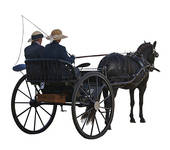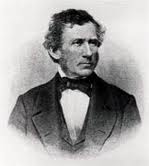
Encyclopedia of asylum therapeutics, 1750/1950s
I have been fascinated with medical history for nearly a decade now so when I saw a chance to review Mary de Young’s book “Encyclopedia of asylum therapeutics, 1750/1950s” I jumped at it. By the time it arrived I was having second thoughts, I have not read anything about the history of psychiatry, the book is an imposing 353 pages of double column text, and I had just struggled through a book that failed to catch my interest at least in part because I felt it lacked organization. This book was obviously organized, as an encyclopedia. I was concerned about its readability, how many encyclopedias compel you to keep reading? This one.
I should have expected that the early treatment for various real and imagined mental disorders would have been based on the same Greek theories of humoral balance as physical medicine was up until the middle of the 19th century. Even the same players were showing up, Dr. Benjamin Rush, a founding father, medical advisor to the Lewis and Clark expedition, and professor of medicine at the College of Philadelphia Department of Medicine turns up in more than a few entries. Benjamin Franklin came up with an electricity based treatment and, when it seemed to work, he wrote that it could have been her faith in the treatment that cured her, not the treatment. This was decades before the term “placebo effect” was even coined. So many of the “treatments” documented here by de Young were also used to treat physical illnesses and she explains them so clearly that this book is a valuable resource for any student of medical history.
If you have ever questioned why so many horror movies are set in asylums this book holds the answer. Bethlem Asylum, also known as Bedlam, and its treatment regimens are frequently discussed and they, and the rational for them, are fascinating. If someone is manic, they need a calming influence, try music, try putting them in a pink room*, try bleeding them, try bathing them in static electricity.** If they are sullen, refuse to interact with the world, raise their spirits, try music, try a green room, try bleeding, try a cat piano, a cat piano is a box containing a number of trapped cats and is equipped with a keyboard that cause a nail studded hammer to hit a cat’s tail. It is believed to be imaginary but imagine the cacophony it would create. I can imagine it would wake the dead as well as get the attention of any mental patient.
In another book that I read recently it was pointed out that in the late 1800s there was a movement painting masturbation as both evil and very dangerous. I noticed in this book a change in the language, before the late 1800s it was very possible to be institutionalized for “excessive masturbation” but then the explanation of a patient’s madness became simply “masterbation”. The extreme range of treatments for any madness that the doctors associated with sex was frightening. “Wiring”, surgical implantation of a wire into the end head of a man’s penis to stop, well, you know what it was intended to stop. This was about the same time that male babies in the US began to be circumcised, not to “prevent disease” but in an attempt to make masterbation less appealing.
More modern treatment are covered, transorbital lobotomy is accompanied by a photograph I found a little disturbing outside of a zombie movie. There is also enlightenment for social commentators on current causes. Ritual clitorectomeys are desturbing in other cultures but before we demonize them maybe we need to understand the use of the procedure, and other sexual surgeries, in our history.
The writing is clear, as clear as the topic permits anyway, and very well documented. The citations are at the end of each section, a system I find much easier to use than crowding all of them in the back of the book. As much as I enjoyed the book it is a very specialized topic. I doubt it will become a bestseller but if you are interested in medical history this book is indispensable.
* As I write this, belittling chromotherapy, the color cure, I see this article about current experiments with using colored light as a treatment. https://clinicaltrials.gov/ct2/show/NCT01782378
** I have to wonder it the ozone produced by the static electricity might have had some effect on the patient, possibly a mild euphoria from the oxygen boost?.






 When I started reading “Summer for the gods: the Scopes trial and America’s continuing debate over science and religion” I thought that I knew something about the Scopes trial. As the author points out, most Americans feel that way. Edward J Larson, the author, is a professor at Pepperdine University. He has both a PhD in history and a law degree which should make him very qualified to write this book. For me the most important part of of the book was the “before” and “after” sections, the actual events of the trial turn out to be less surprising, and less important, than why it happened and what the results were.
When I started reading “Summer for the gods: the Scopes trial and America’s continuing debate over science and religion” I thought that I knew something about the Scopes trial. As the author points out, most Americans feel that way. Edward J Larson, the author, is a professor at Pepperdine University. He has both a PhD in history and a law degree which should make him very qualified to write this book. For me the most important part of of the book was the “before” and “after” sections, the actual events of the trial turn out to be less surprising, and less important, than why it happened and what the results were. I would argue that there was a major change in the study of history that began sometime around 1961 roughly with the publications of Edward Hallet Carr’s work, “What is History?” Although I use that as a marker I think the change had more to do with the G I Bill financed history professors coming into their professional prime about that time. They had a wider life experience than the WASP professors of earlier times. After the 1960s a wider range of players began to turn up in scholarly works of history. By the 1990s history was told in a way that included both sexes and all genders, all colors, all nationalities, and most economic levels.
I would argue that there was a major change in the study of history that began sometime around 1961 roughly with the publications of Edward Hallet Carr’s work, “What is History?” Although I use that as a marker I think the change had more to do with the G I Bill financed history professors coming into their professional prime about that time. They had a wider life experience than the WASP professors of earlier times. After the 1960s a wider range of players began to turn up in scholarly works of history. By the 1990s history was told in a way that included both sexes and all genders, all colors, all nationalities, and most economic levels. I have been researching the life and times of Daniel Drake for a few years now. Originally I wanted to publish an article to help me get into grad school but that has been put on hold. That might be a good thing if it depends on me publishing an article. Studying a persons life turns out to be much easier when you understand the times they lived in, if you don’t understand their times you will miss most of the story.
I have been researching the life and times of Daniel Drake for a few years now. Originally I wanted to publish an article to help me get into grad school but that has been put on hold. That might be a good thing if it depends on me publishing an article. Studying a persons life turns out to be much easier when you understand the times they lived in, if you don’t understand their times you will miss most of the story.

